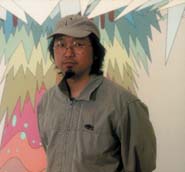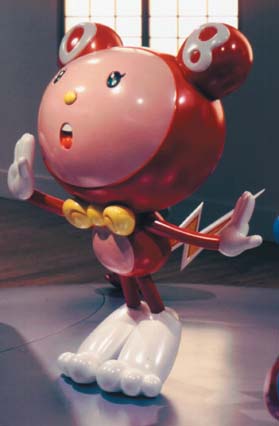East meets
West
Japanese art from today and yesterday is
unveiled at the Museum of Fine Arts
by Scott Roberto
 East, West, old and new-these four seemingly opposing concepts collide at the Museum of Fine Arts in two new exhibits that uphold the institution's long history of showcasing works from the Land of the Rising Sun, while taking a revealing look toward the future. Long renowned for its collections of Asian art-indeed, it was one of the first Western museums to accumulate pieces from the Far East on a large scale-the MFA further strengthened its collection with the acquisition of prints that form the foundation of
Japan at the Dawn of the Modern Era: Meiji Prints from the Jean S. and Frederic A. Sharf
Collection. And though Japan may seem its only East, West, old and new-these four seemingly opposing concepts collide at the Museum of Fine Arts in two new exhibits that uphold the institution's long history of showcasing works from the Land of the Rising Sun, while taking a revealing look toward the future. Long renowned for its collections of Asian art-indeed, it was one of the first Western museums to accumulate pieces from the Far East on a large scale-the MFA further strengthened its collection with the acquisition of prints that form the foundation of
Japan at the Dawn of the Modern Era: Meiji Prints from the Jean S. and Frederic A. Sharf
Collection. And though Japan may seem its only connection, Takashi Murakami: Made in Japan-the first solo exhibition at a major museum by the eponymous artist-is a fascinating complement to the more traditional Meiji prints.
The Meiji ("Enlightened Rule") period of Japan (1868- 1912), from which the color woodblock prints of the first exhibit arise, was one of the greatest periods of transition in the history of Japanese society. This era, spearheaded by the Emperor Meiji, marks the beginning of Japan's assimilation of Western customs and technology into its own culture. The brilliantly colored images on display reflect the many changes that were transforming the previously isolated island nation. The primitive, traditional medium of woodblock printing would seem a strange choice for documenting the growth of Japan into a modern, Westernized nation, but these incredibly detailed, vibrant pieces were cheap and easily obtained-and thus immensely popular. One notable change was the adoption of Western dress, as shown in a print depicting the Emperor's family engaging in the customary springtime activity of viewing cherry blossoms, with the women of the court dressed in Victorian-era bustles and bonnets. Pictures such as these endeared the Emperor to his subjects and served to encourage his people to adopt Western customs. Make no mistake-the prints on display acted as valuable propaganda in this tightly controlled society. Nowhere is this more apparent than in the imagery glorifying the might of the Meiji-era Japanese military. Battles and victories of both the Sino-Japanese (1894- 1895) and Russo-Japanese (1904-1905) wars-inspiring worldwide respect for the Japanese war machine-were widely reproduced by hosts of artists from sketches made on the front lines by war correspondents like national hero Kubota Beisen, who is depicted in one of the prints on display. On a lighter note, the 17 paintings and lone sculpture that comprise the Takashi Murakami show in the Foster Gallery would seem a stark contrast to the Meiji prints. Highly influenced by anime and manga (the Japanese terms for animation and comics, respectively), Murakami's often whimsical and sometimes psychedelic imagery suggests shades of Andy Warhol and his Pop Art brethren. Murakami has even created his own line of products featuring his Mickey Mouse-like character, Mr. DOB, who appears in several of the large-scale works in the MFA show. Despite this, Murakami-who has a degree in
nihon-ga, a Meiji-era painting style that synthesizes Eastern and Western techniques-remains inspired not just by pop culture, but Japan's past as well. Two 18th century scrolls by so-called "eccentric" artist Soga Shohaku from the museum's collection are also displayed to show Murakami's connection to Japan's rich artistic tradition.
|


